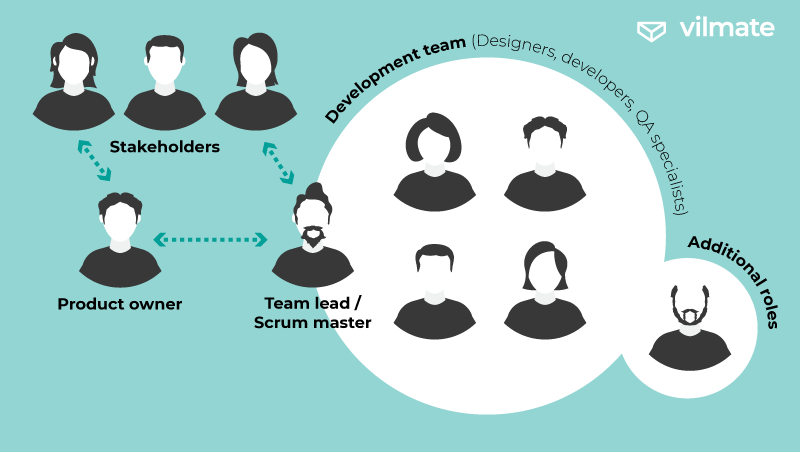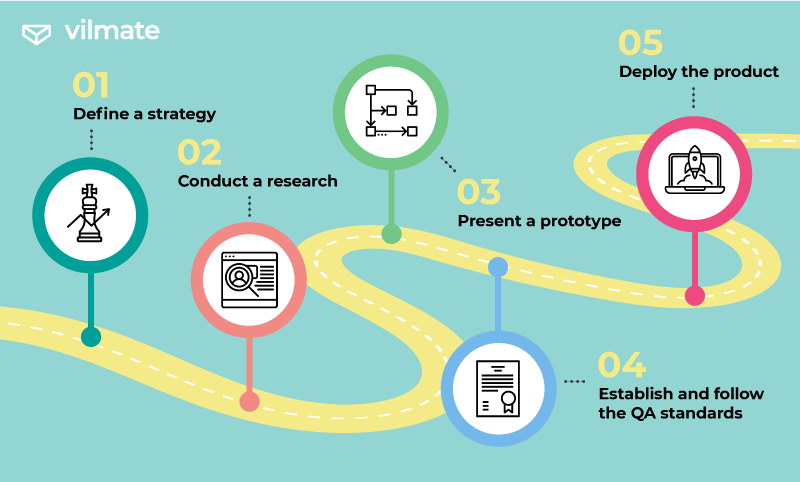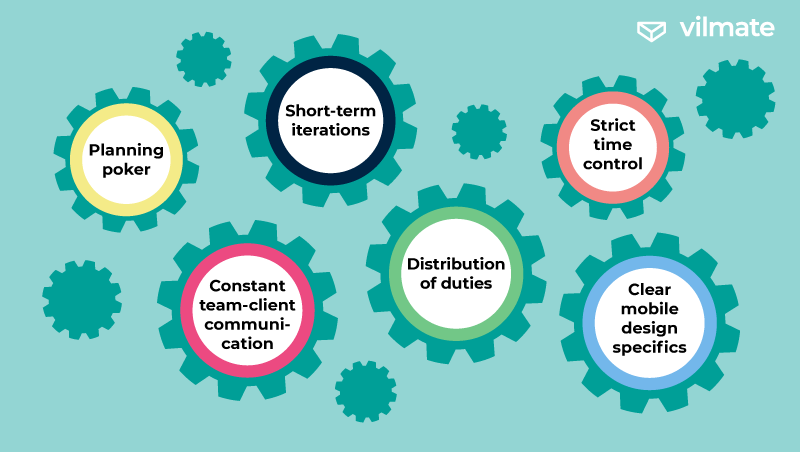Decades of intensive evolution of the programming field have spawned numerous techniques and software development approaches. All of them have their benefits and drawbacks for a development team and may vary in efficiency depending on the assigned mission as well as an expected outcome.
In this text, we’ll be focusing on agile mobile app development. We’ll discuss what actually stands behind agile software development methodology, its major pros, and why it works best for mobile app development. Also, we’ll note how agile development principles help the development team of Vilmate deliver high-quality service for years and keep our customers’ satisfaction level on top.
The global popularity of agile development methodology
Are agile practices really so spread around the world? The answer – they definitely are. Forbes devotes massive amounts of space to talk about it, the authoritative portal of MarketWatch claims that it’s not going to leave the top trends in the next several years, and Project Management Institute isn’t shy to speculate on the topic of other industries adopting agile management models.
The number of digital tools for convenient establishing and monitoring of tasks and subtasks in the projects sticking to agile development is another proof of unabating topic relevance. Products like Jira and Visual Studio Team Services or platforms like Monday are still in high demand.
So let’s quickly refresh our knowledge on the basic principles of agile in project management and what makes it so universal and widely spread.
What stands behind agile software development
Agile development resembles hydrogen – it can be found almost anywhere in the universe due to its lightness and compatibility with other elements. The ubiquity of agile tools and techniques in software development is reasonable and justified as it’s convenient for everyone, from product owners to QA testers.
Primary team roles following agile
And by the way, let’s list the roles in the average development team and their responsibilities in a project. It will help us see the interactions between parties more clearly and why agile development methodologies fit them.

Product owner
The product owner is the person who owns the product. They are responsible for making sure that the product meets all of the customers’ needs and is viable in the market. Product owners are also responsible for identifying what features or enhancements will make a customer want to buy a product. This can be done by researching, talking to customers, and looking at competitors’ products. The company’s management team will often assign a specific person to be the product owner for each project or new release of an existing product.
Stakeholders
The roles of stakeholders vary depending on the project. Product owners can also be stakeholders, as well as other team members. Commonly, being a stakeholder refers to investors, business executives, and end users. They may not be directly involved in the process of development, but they should be able to provide input at all stages for a better user experience. They provide feedback, give approvals, agree on estimations, and may contribute on every iteration of the project development process.
Team lead/Scrum master
The names team lead and scrum master are often used interchangeably. In any case, they’re responsible for making sure that the development team adheres to the development process. He or she makes sure that all of the necessary tasks are completed in a timely manner and that there’s no confusion on sprint planning or sprint review. They also facilitate communication between different teams and stakeholders, if needed. The team lead or scrum master should be knowledgeable about scrum methodology and agile software development lifecycle. He or she should be able to answer any questions from the development team members, help them understand their roles, and provide advice on how to resolve any issues that arise.
Development team members
These are the people who apply their technical knowledge in order to create and maintain a software product. They’re the backbone of any project as they turn plans and expectations related to app building into reality. Product designers, coders, QA and UX specialists usually form the core of an efficient development team in creating the product as per the requirements and specifications. In many cases, the members of an experienced development team are self-organizing and work in parallel, with each member contributing their own skills to the project.
Additional roles
Large-scale projects for big enterprises may require some additional specialists’ involvement. Domain experts, third-party audit teams, or integrators for coordinating subsystems may also play an important role in agile development and maintenance. They can be added from the very stage of initial planning or on the go – if the project sticks to agile, it implicates flexibility in that matter.
Basic principles of agile development
So now, as we know who does what, we can focus on the core principles of agile methodology. Regardless of the project scale and type, they have to remain solid with some minor changes when necessary.
Agile application development is a framework that is focused on delivering working software to end users. It is based on an iterative and incremental approach, where the development team creates a product in small pieces.
Following agile software development methodology, teams are empowered to decide how they will work. They decide what approach they will use and what tools and processes will best suit their situation. This freedom allows the team members to collaborate more effectively, develop a deeper level of mutual trust, and create a process that is tailored specifically to the team’s needs.
The most common agile frameworks are as follows:
- Adaptive software development
- Dynamic systems development method
- Feature-driven development
- Scaled agile framework
- Rapid application development
- Scrum
Each of these frameworks deserves a text of its own, but here we have to stick to our own topic. Besides, their names speak for themselves in terms of the general concept.
Let’s now see why agile works best, particularly in the mobile app development field, and the benefits it brings to the table.
Why agile fits mobile app development
Naturally, mobile applications should be more flexible and user-responsive than desktop apps. More to the point, providing mobile app development services is a complex process with many stages that need to be completed. Agile methodology is the most suitable way of handling this, and it’s a good fit for mobile app development.
Mobile app development basics include a number of steps for each mobile app developer to know. Let’s cover these basic stages of the mobile application development process, what their purpose is, and why they should be applied in this order.

1. Defining a mobile strategy
It’s important for a mobile app development company to have a strategy in place before starting the development process. It helps them understand what they want from their mobile app and how it should work. Designing a mobile app development plan is the first step that will set the tone for further product existence.
2. Conducting user research
User research is also essential for understanding user needs and behavior. It will help in designing the features of the mobile application for the best user experience.
3. Presenting wireframes & prototypes
Wireframes are used by app developers for planning the application layout. At the same time, prototypes are used to test out different ideas before committing to one design in the process of mobile app development.
4. Establishing QA testing standards
Quality assurance testing is also an important step in the agile mobile app development process as it ensures that there are no bugs or glitches in the final version of the mobile application when deployed on various devices.
5. Deploying & releasing a product
Deployment is the process of moving a product by app developers from one environment to another. It is the final part of the mobile application development, and it has to be done in a way that ensures that the product does not lose any data or functionality. The release phase is when we create and prepare packages for deployment.
Agile mobile app development relies on iterative and incremental app building. It is a type of project management process that involves working closely with the customer, who is often an end user of the product.
So which benefits does agile app development provide in terms of creating a mobile application?
- Flexibility: Agile application development allows for changes to be made at any point in the project lifecycle as long as there is time left in the sprint.
- Adaptability: The process allows for changes to be made to the product without requiring extensive rework of an agile team.
- High-quality level: Agile app development provides a consistent level of quality because it can catch bugs and errors early in the development process and before they are released into production.
- Labor performance efficiency: A shorter release cycle means that less time and resources are wasted on tasks that may not ultimately matter to users or customers.
- Cost efficiency: Naturally, efficient allocation of material and mental resources, as well as reasonable prioritizing, leads to the reduction of costs. Which, in its turn, may result in quicker product growth and enlarge the business scale.
And now, for this text not to be just plain words, we’d like to briefly tell about the real-life case of participation in a mobile app development project with an agile development approach.
How Vilmate applies agile in mobile app development projects
A good example of agile implementation at Vilmate is Jobcast. The case of Jobcast is quite interesting since the tasks that were put in front of our team were far from trivial.
The main idea of the project is to provide a connection between employers and job seekers in the form of audio recordings. The created online platform allows users to submit and transmit audio files in the form of a podcast to ensure employment-related information exchange between recruiters, employers, and candidates.
Our development team was responsible for developing Jobcast mobile applications for iOS and Android from scratch. We managed to provide a fully functional audio player, a payment system, and adjustable profile settings for job searching and posting.
The client had a fully functional website and a clear product vision, which served as a sound basis for precise estimations and product development implementation.

Our project managers successfully applied the following agile techniques:
- Planning poker or Scrum poker to understand the time frames for implementing operational features for the mobile application.
- Short-term iterations for reducing risks and having a wider window for solving potential mobile app development issues.
- Strict time control and distribution of duties to exclude team overloads and provide a full understanding of roles for each team member.
- Constant team-client communication for the most efficient collaboration and mutual rapport in the mobile application development process.
- Setting clear mobile design specifics to ensure the maximum expected outcome in the final version of the product.
As a result, with the help of Python for the backend and React Native for mobile IoS and Android applications, we managed to provide solutions that fully met all the expectations.
And it’s always pleasant to receive positive feedback after the job is done :)
Transparent and proactive, Vilmate delivered outstanding software development services, which resulted in a successful product launch. Their excellent technical skills and commitment to customer service made them a perfect fit for our company.
Final words
As you can see, agile application development is a logical response to modern software expectations and demands, including mobile app development. It provides flexibility, gives an opportunity to set your own pace in project implementation, and to react quickly to shifting priorities of agile mobile app development.
Here, at Vilmate, we devote much attention to time control, communication with clients, and careful planning. We realize that inaccurate estimations and mismanagement may turn out in substantial losses in the latter steps of product development and deployment.
Check our Portfolio and Services sections since agile is present there in all mentioned cases to some extent. Also, browse through our Technologies to find some options for your existing or potential projects. Pay close attention to mobile app development and UI/UX design to be assured that our specialists are seasoned enough in all spheres. And contact us any time of the day, we’ll be glad to answer any of your questions.
And the last thing, try to follow Mohammad Ali’s strategy in any of your endeavors – float like a butterfly, sting like a bee :)
Stay tuned with Vilmate! There are still many topics to talk about :)




